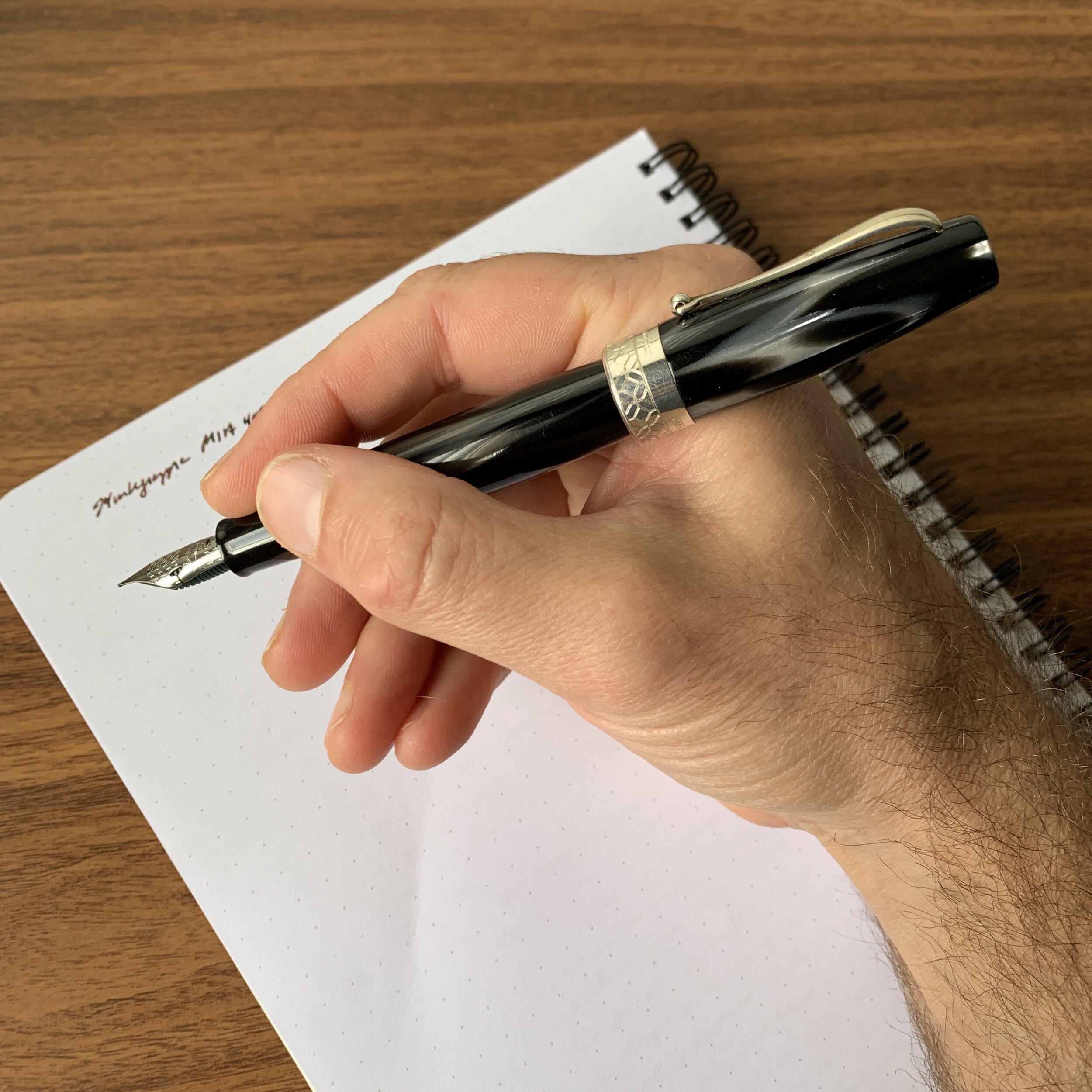It might surprise you to hear that Montegrappa has become one of my favorite pen brands, and we’re talking top three. While the Italian company attracts a lot of attention for its high-profile, ultra-limited edition brand collaborations such as the Lord of the Rings and Game of Thrones releases, the best of what Montegrappa has to offer, in my opinion, lies in their classic, vintage-inspired lineup that includes pens such as the Extra 1930 and Miya, which I’ll review here.
Put simply, I find the Miya one of the most comfortable pens on the market today. I have written with my two Miyas for hours over the past three weeks. The contoured barrel sits perfectly in my hand, and the tapered end allows the cap to post at what is, for me, the perfect depth. The fact that the Miya uses a cartridge-converter filling system reduces the weight of the pen and creates an exceptionally well-balanced writing instrument.
The versatility of this design makes the Miya more suitable to “dressing up and down” than other Montegrappa pens. As shown here, Montegrappa has offered the Miya in both the “Miya 450” limited edition celluloid variant, as well as the resin “MIA” limited edition sold by shops in Italy such as Casa della Stilografica. While the underlying pen is the same, featuring an identical shape and cartridge-converter filling system, the Miya 450 features celluloid construction, hand-engraved sterling silver trim, and Montegrappa’s 14k “high flex” nib, which I recently reviewed. The “MIA,” on the other hand, still showcases the unique materials that Montegrappa is known for, but with fewer bells and whistles on the trim that allows them to offer this pen at a (relatively) more accessible price without sacrificing the luxury feel.
The resin on the Montegrappa MIA “Meteor Shower” is a collection favorite. I’ve had to resist getting the other three in different color striated materials. (Links below)
I’ll conclude my review by noting that Montegrappa has been well-served by the move to JoWo nibs. Both the 14k and stainless steel nibs that have shipped on my Montegrappa pens since the company changed over from Bock have written exceptionally well, with none of the hard-starting and ink starvation issues that I sometimes experienced back when they still sourced their nibs from Bock. While some will quibble that they are “boring,” the fact is that they are far more reliable writers than most anything on the market, and easy to customize should you desire a specialty grind.
Two Montegrappa 14k JoWo nibs. Note that I swapped the steel nib in my MIA Meteor Shower for the 14k gold nib from my Monte-Grappa. Montegrappa JoWo nibs are interchangeable, but they do not use threaded nib units so you will have to pull them manually. (The EF steel nib that shipped on my Meteor Shower wrote perfectly well, I just swapped them out because I wanted to experiment with interchangeability.)
Takeaways and Where to Buy
Personally, I would love to see more Miya/MIA models released in the U.S. The comfortable shape and versatility of the cartridge-converter format makes me think this pen would have wide appeal, and in my opinion, it’s more attractive and more comfortable to use than the Fortuna series. Honestly, if Montegrappa wants to continue to target the $200-300 price point for a steel nib pen, the Miya strikes me as a better fit. This pen feels more substantial than the Fortuna, and with limited edition acrylics thrown into the mix, it presents a better justification for the price point.
I acquired the Miya 450 featured in this review directly from Kenro Industries, the U.S. Montegrappa distributor, at this year’s Baltimore Pen Show. Though a limited edition, Nibs.com has the pen in stock in all five colors, priced at $796. The “MIA” in “Meteor Shower” resin was purchased from Casa della Stilografica in Florence, Italy, which also sells limited edition steel-nib pens in two other striated materials: “Spicy Explosion” and “Adriatic Sea.” Though still expensive, these pens are priced at a more accessible $280 USD (subject to exchange rate fluctuations). I do not believe there is a steel-nib version of this pen currently available in the United States.
Disclaimer: I acquired the Montegrappa Miya 450 from Kenro Industries, the U.S. Montegrappa distributor, at a discount, as part of their sponsorship of this blog. I acquired the “Meteor Shower” MIA from Casa della Stilografica at standard retail using my own funds. This post does not contain affiliate links.

